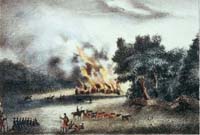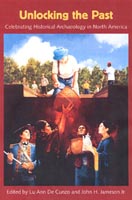Black
Seminole Freedom Fighters on the Florida Frontier
by Terry Weik

Burning of Pilaklikaha by General Eustis. (Courtesy of Library of Congress.)
As a result of archaeological
research, I have learned that African and African-American freedom fighters
persistently challenged racism and slavery in the Americas from the beginning.
Wherever and whenever slavery occurred, Maroons were there, fighting for a
break from their toils or for the freedom to build their own communities.
At times, they went on the offensive and helped their enslaved peers escape
from plantations. Maroons in places such as Jamaica and Surinam were so successful
that thousands of their descendants still own their lands and celebrate their
heritage today. Black Seminole Maroons pursued a path to freedom that began
and ended deep in "Indian Territory." While in Florida, Maroons
became Black Seminole by joining forces with the Seminole Indians and held
off the advances of slavers, land-hungry settlers and soldiers from the United
States.
At a Florida Black Seminole Maroon settlement called Abraham's Old Town,
archaeological research has unearthed artifacts and dusted off documents
that illustrate the lives of these extraordinary people who share a dual
African and Native American heritage. Some basic questions have driven my
research on Abraham's Old Town. First, who were these Maroons? Did they
establish new settlements that were independent of enslaved peoples, Native
Americans, and colonists? Why did the Black Seminole Maroons succeed, while
most enslaved African rebels were quickly suppressed? I sought to explore
how this group of people so diverse in languages, cultural beliefs, and
political interests managed to reconcile their differences and build a society
from scratch.
Sidebar 5: Fort Mose, St. Augustine, Florida - Lu Ann De Cunzo
Terrance
Weik is assistant professor of anthropology at the University
of South Carolina.

